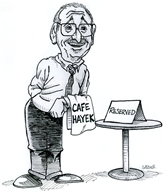GMU Econ alum Dominic Pino is correct: “Peter Navarro is not the way” (and nor is Ron Vara). A slice:
Perhaps crazier than all of this, though, is one of Navarro’s frequently quoted sources in his published work. “Ron Vara” is the name of an anti-China economist who is quoted more than a dozen times across five of Navarro’s books. He’s a fellow Harvard grad who served as a reservist during the Gulf War. The thing is, he doesn’t exist. “Ron Vara” is an anagram of “Navarro.” After a researcher noticed the anomaly in 2019, Navarro admitted to having invented him.
Navarro needs to make up economists who agree with him because his economic views are incorrect. As Ryan Bourne wrote for CapX in 2017, Navarro holds at least four beliefs on trade economics that are simply wrong: imports reduce GDP, goods exports are inherently better than services exports, bilateral trade deficits are always problems, and higher trade deficits are associated with lower investment. These errors range from treating accounting identities as economic value statements to sentimentalism for the good old days that never existed.
Navarro is one of the folks who thinks China’s joining the World Trade Organization was a uniquely destabilizing and damaging event in U.S. economic history. He expounded this view in a feature-length film narrated by Martin Sheen in 2012, Death by China, which posits that a flood of cheap imports from China when U.S. trade barriers were removed has destroyed U.S. manufacturing. As Daniel Griswold wrote in a 2017 review of the film, this simply is not true.
Ben Charoenwong explains that “trade wars can discourage domestic production.” A slice:
Tariffs intended to bring manufacturing home may actually accelerate the exodus of production. Early market evidence suggests this is what Mr. Trump’s chaotic trade policy is doing. TSMC illustrates why. By shifting some production to Arizona, the Taiwanese company is strategically positioning itself to avoid tariffs that might hamper its access to its predominantly North American customer base, including Apple and Nvidia. But reaching customers isn’t a problem unique to foreign firms. For U.S. companies that predominantly serve customers abroad, tariffs and the risk of retaliation can lead them to increase relationships with foreign suppliers and loosen ties with domestic ones.
In responding to tariffs or other trade restrictions, a crucial issue businesses have to consider is the cost of distribution to customers. For companies with mostly domestic customers, trade policy uncertainty may indeed encourage reshoring. Intel’s decision in 2022 to invest $20 billion in semiconductor fabrication facilities in Ohio made strategic sense because a significant portion of its customer base is domestic and Washington was making noise about limiting strategic tech entanglement with foreign supply lines, especially connected to China. If Intel’s production remained abroad, tariffs or other trade restrictions done in the name of national security could restrict the company’s access to its primary market.
But this calculus is flipped for firms that get most of their revenue from foreign sales. These companies face a stark choice: continue manufacturing in the U.S. and risk being caught in the trade-war crossfire, or relocate their entire supply chains overseas to bypass American borders and thereby retaliatory tariffs.
Relocating and changing supply chains is costly, but it can quickly become the cheaper option over weathering unknown, potentially sudden production cost hikes due to volatile trade policy. As attitudes in the U.S. have turned against free trade over the past decade, some companies seem to have already decided restructuring is worth the price.
Jim Dorn rightly recommends the remarkable 1954 monograph – titled Free Trade: America’s Opportunity – by our teacher Leland Yeager. Three slices:
In 1954, the Robert Schalkenbach Foundation published a small book by Leland B. Yeager titled, Free Trade: America’s Opportunity. In it, he presents a concise but rigorous defense of free trade—both as a normative principle and a system that has a large net benefit to the world in terms of expanding the range of choices open to people and increasing the wealth of nations. This article provides a summary of some of Yeager’s key points that are relevant to current trade policy.
…..
Yeager emphasizes that “free trade means letting people buy and sell as they see fit, abroad as well as at home.” In contrast, “protectionism means using the force of government to keep people from trading as they see fit or to fine them for it. Free trade does not force; it permits.” By harnessing government power to restrict free trade, protectionism diminishes individual freedom and expands government coercion.
…..
President Trump’s ultimate goal is not free trade; it’s to “make America great again” by being more self-sufficient and protecting American jobs. His tariffs are not reciprocal, they are meant to keep China out of our neighborhood. He fails to recognize that the purpose of free trade is not to create jobs, but to expand the range of choices open to people, and allow Americans to increase consumption beyond domestic production. Tariffs are not “beautiful,” they reduce economic and personal freedom, and stir crude nationalism.
Wall Street Journal columnist Allysia Finley appropriately criticizes Democrats for their hypocrisy on tariffs. Two slices:
Massachusetts Sen. Elizabeth Warren decries President Trump’s tariffs as “economic sabotage” and urges Congress to stop them. But when running for president in 2019, she pledged to use “economic patriotism to overhaul our approach to trade” and punish countries that don’t adhere to U.S. environmental and labor standards.
If Democrats genuinely opposed his tariffs, they could file lawsuits to stop them, as they have almost everything else his administration has done. They also could have passed legislation under Joe Biden that would have prevented the tariffs. They don’t and didn’t, because their tariff opposition is more political than principled.
Democrat-led states would have a strong legal argument that Mr. Trump’s “Liberation Day” tariffs, as well as earlier ones on China, Mexico and Canada, exceed a president’s powers under the International Emergency Economic Powers Act of 1977, or IEEPA. The law allows presidents to impose sanctions on foreign adversaries during national emergencies, but makes no mention of tariffs.
Perhaps Democrats don’t sue because they hope that the economic damage from the tariffs will help their party. Public opinion of Democrats hit a record low last month, but now they can pretend to defend middle-class Americans against higher prices. That was hard to do under Mr. Biden when their spending fueled runaway inflation.
Or perhaps Democrats don’t want to cross labor unions, which generally support tariffs. United Auto Workers President Shawn Fain has praised Mr. Trump’s tariffs on cars and trucks, which were dubiously premised on protecting national security. If unions had their way, tariffs would return to the astronomical levels under the Smoot-Hawley Act of 1930.
…..
There was also a bipartisan push in 2021 to require Section 232 national security tariffs—such as Mr. Trump’s on steel, aluminum and autos—to be approved by Congress. A Senate bill garnered 11 Republican co-sponsors—enough to have overcome a GOP filibuster had then-Majority Leader Chuck Schumer rallied his caucus to support it. He didn’t.
Why not? Because Democrats’ Big Labor friends support tariffs. Nonetheless, Democrats who didn’t support earlier efforts to limit a president’s tariff power when they might have had a chance of succeeding are now backing legislation to repeal Mr. Trump’s “Liberation Day” tariffs.
Democrats know such legislation won’t pass the Republican Congress, let alone be signed by Mr. Trump. They protest his tariffs because they are politically unpopular, and they know they won’t pay a price for the messaging exercise with their labor friends.
“Mike Pence urges Congress to reclaim constitutional authority on tariffs.” A slice:
Pence made the “Case for the Constitution” last week in a closed-door speech at Grove City College’s Conference on Faith and Freedom, according to excerpts of his remarks obtained by National Review.
“The Constitution gives the power to Congress to set policies on tariffs, trade and commerce. Wherever you come down on the risks or merits associated with tariffs imposed by the Trump Administration, the president has no authority in the Constitution to unilaterally impose tariffs without an act of Congress,” Pence said.
“While I welcome President Trump’s decision to pause many of his announced tariffs for 90 days, the truth is — had we adhered to the Founders’ intent in the Constitution — the stops and starts of the past week could never have happened.”
Reason‘s J.D. Tuccille explains that “even on pause, Trump’s trade war runs up a big price tag.” A slice:
The Tax Foundation has also been tracking the cost of the trade war in an ongoing analysis by Erica York, vice president of federal trade policy, and senior economist Alex Durante. As of April 11, they “estimate tariffs will cause imports to fall by slightly more than $800 billion in 2025, or 24 percent.” Revenue-wise, they see tariffs raising $2.2 trillion over the next decade. Obviously, that big an effect on trade will also have an impact on the U.S. economy.
“We estimate that before accounting for any foreign retaliation, Trump’s tariffs will reduce long-run US GDP by 0.8 percent,” York and Durante warn. “As of April 10, threatened and imposed retaliatory tariffs affect $330 billion of US exports based on 2024 US import values; if fully imposed, we estimate they would reduce US GDP by 0.2 percent. Combined, the US-imposed tariffs and the threatened and imposed retaliatory tariffs reduce US GDP by 1.0 percent.”
Judging by the results, the United States should be the last country that wants to re-order the world economy.
We’ve thrived in recent decades, while other advanced democracies have fallen behind.
If we’ve gotten “ripped off” as President Donald Trump and supporters of the trade war like to say, the supposed thieves have gained little and the purported victim has continued to march ahead.
…..
As The Economist magazine noted in a cover story last year, “In 1990 America accounted for about two-fifths of the overall GDP of the G7 group of advanced countries; today it is up to about half.”
We roughly doubled the gap in our per-person output over Europe and Japan across those decades.
Since 2020, we grew three times as fast as the G7. Overall, whereas we were 21% of global GDP in 2012, now we are 26% — right about where we were in 1980.
…..
Here, Trump is using a defibrillator on a patient who not only passed his stress test with flying colors, but is beating everyone else in the 100-yard dash.
It’s not a coincidence that unions are often corrupt. It’s a natural consequence of U.S. labor law, which gives a union monopoly power as the exclusive bargaining agent over a workplace. Once it is ensconced, it rarely has to justify its existence again, such that 95 percent of American private-sector union members never voted for the union that represents them. Monopoly power and little accountability is a recipe for corruption.



